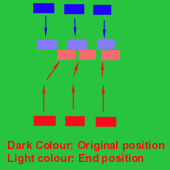 |
allow you to break through over the whole widt, but offers you little in the sense of tactical manoeuverability gives you the opportunity to either pressure one of the flanks to give in, or through a variation of firepower apply considerable pressure on both flanks alternately. It will become simple calculation: the pressure of two squads applied to one enemy squad will eventually make the enemy squad retreat or die. However:
- If the enemy is smart enough, it will use the unopposed flank to cover the fire issued by your support fire squad. In doing this it will be able to counter your fire without actually getting fired upon.
- The enemy might just revolve away from your pressure, or start an envelopment, thereby suddenly ending up in your rear. Battles where this was used:
- Alexander the Great in his last battle against Darius of the Persians. Although outnumbered he started an attack, not over the whole of the front, but specifically aimed at one of the flanks, managed to break through, thereby entering the rear of the Persian Army.
- A master of the oblique movement was Frederick the Great, in several of his battles he managed to use this to the surprise of the enemy. His battles are worth studying. (Unfortunatekly it had grown into the �national� tactic by the time Napoleon was knocking on the Prussian door, so he saw it coming from a mile away...) |
 |
